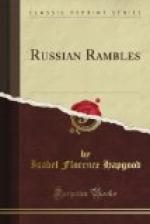From our post at the head of the Prospekt we behold not the ceremony itself but the framework of a great national picture, the great Palace Square, whereon twenty thousand troops can manoeuvre, and in whose centre rises the greatest monolith of modern times, the shaft of red Finland granite, eighty-four feet in height, crowned with a cross-bearing angel, the monument to Alexander I. There stand the Guards’ Corps, and the huge building of the General Staff, containing the Ministries of Finance and of Foreign Affairs, and many things besides, originally erected by Katherine II. to mask the rears of the houses at the end of the Nevsky, and rebuilt under Nicholas I., sweeping in a magnificent semicircle opposite the Winter Palace. Regiments restrain the zeal of the crowd to obtain the few posts of vantage from which the consecration of the waters is visible, and keep open a lane for the carriages of royalty, diplomats, and invited guests. They form part of the pageant, like the Empress’s cream-colored carriage and the white horses and scarlet liveries of the Metropolitan. The crowd is devout and silent, as Russian crowds always are, except when they see the Emperor after he has escaped a danger, when they become vociferous with an animation which is far more significant than it is in more noisy lands. The ceremony over, the throngs melt away rapidly and silently; pedestrians, Finnish ice-sledges, traffic in general, resume their rights on the palace sidewalks and the square, and after a state breakfast the Emperor drives quietly home, unguarded, to his Anitchkoff Palace.
If we glance to our left, and slightly to our rear, as we stand thus facing the Neva and the Admiralty, we see the Prefecture and the Ministry of War, the latter once the mansion of a grandee in the last century; and, rising above the latter, we catch a glimpse of the upper gallery, and great gold-plated, un-Russian dome, of St. Isaac’s Cathedral, which is visible for twenty miles down the Gulf of Finland. The granite pillars glow in the frosty air with the bloom of a Delaware grape. We forgive St. Isaac for the non-Russian character of the modern ecclesiastical glories of which it is the exponent, as we listen eagerly to the soft, rich, boom-boom-bo-o-om of the great bourdon, embroidered with silver melody by the multitude of smaller bells chiming nearly all day long with a truly orthodox sweetness unknown to the Western world, and which, to-day, are more elaborately beautiful than usual, in honor of the great festival. We appreciate to the full the wailing cry of the prisoner, in the ancient epic songs of the land: “He was cut off from the light of the fair, red sun, from the sound of sweet church-bells.”
On the great Palace Square another characteristic sight is to be seen on the nights of Court balls, which follow the Jordan, when the blaze of electric light from the rock-crystal chandeliers, big as haystacks, within the state apartments, is supplemented by the fires in the heater and on the snow outside, round which the waiting coachmen warm themselves, with Rembrandtesque effects of chiaro-oscuro second only to the picturesqueness of dvorniki in their nondescript caps and shaggy coats, who cluster round blazing fagots in less aristocratic quarters when the thermometer descends below zero.




